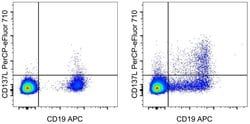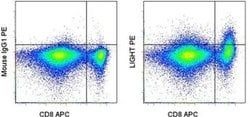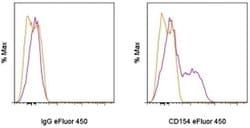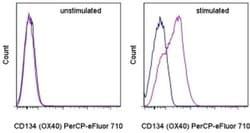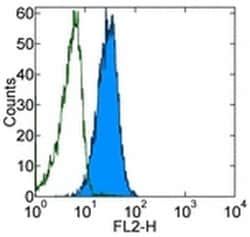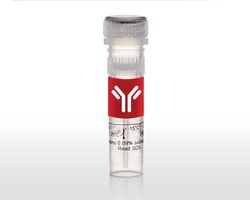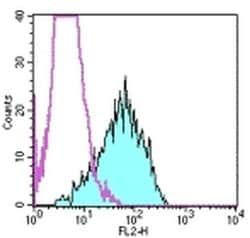CD178 (Fas Ligand) Monoclonal Antibody (MFL3), Biotin, eBioscience™, Invitrogen™
Manufacturer: Invitrogen
Select a Size
| Pack Size | SKU | Availability | Price |
|---|---|---|---|
| Each of 1 | 50-112-2560-Each-of-1 | In Stock | ₹ 16,821.00 |
50-112-2560 - Each of 1
In Stock
Quantity
1
Base Price: ₹ 16,821.00
GST (18%): ₹ 3,027.78
Total Price: ₹ 19,848.78
Antigen
CD178 (Fas Ligand)
Classification
Monoclonal
Concentration
0.5 mg/mL
Formulation
PBS with 0.09% sodium azide; pH 7.2
Gene Accession No.
P41047
Gene Symbols
Fasl
Purification Method
Affinity chromatography
Regulatory Status
RUO
Gene ID (Entrez)
14103
Content And Storage
4° C, store in dark, DO NOT FREEZE!
Form
Liquid
Applications
Flow Cytometry
Clone
MFL3
Conjugate
Biotin
Gene
Fasl
Gene Alias
ADAM10-processed FasL form; ALPS1B; APL; Apoptosis (APO 1) antigen ligand 1; apoptosis (APO-1) antigen ligand 1; Apoptosis (APO-1) antigen ligand 1 (Fas antigen ligand); apoptosis antigen ligand; APT1LG1; APTL; CD178; CD178 antigen; CD95 ligand; CD95 ligand protein;Generalized lymphoproliferative disease (Gld); Cd95l; CD95-L; CD95L protein; fas antigen ligand; Fas ligand; Fas ligand (TNF superfamily, member 6); Fasl; Fas-L; FasL ICD; FasL intracellular domain; Faslg; Fas-LG; generalized lymphoproliferative disease; gld; mutant tumor necrosis factor family member 6; Receptor-binding FasL ectodomain; sFasL; Soluble Fas ligand; soluble form; SPA; SPPL2A-processed FasL form; TNFL; Tnfsf6; TNLG1A; Tumor necrosis factor (ligand) superfamily member 6; Tumor necrosis factor (ligand) superfamily member 6 (apoptosis (APO-1) antigen ligand 1) (Fas antigen ligand); Tumor necrosis factor (ligand) superfamily, member 6 (apoptosis (APO-1) antigen ligand 1) (Fas antigen ligand); Tumor necrosis factor
Host Species
Armenian Hamster
Quantity
100 μg
Primary or Secondary
Primary
Target Species
Mouse
Product Type
Antibody
Isotype
IgG
Description
- Description: The MFL3 monoclonal antibody reacts with mouse Fas (CD95) Ligand, a 40 kDa type II transmembrane glycoprotein
- FasL is a member of the TNF family and is expressed by mouse activated T cells
- The interaction of FasL with its receptor CD95 induces Fas-mediated killing
- It has been reported that the human FasL antigen is cleaved from the surface by matrix metalloproteinases (MMPs), resulting in a 26 kDa soluble form
- The degree of sensitivity for the mouse antigen to MMPs has not been reported
- Applications Reported: The MFL3 antibody has been reported for use in flow cytometric analysis
- Applications Tested: The MFL3 antibody has been tested by flow cytometric analysis of mouse FasL transfected cells and activated T cells
- This can be used at less than or equal to 0.25 μg per test
- A test is defined as the amount (μg) of antibody that will stain a cell sample in a final volume of 100 μL
- Cell number should be determined empirically but can range from 10^5 to 10^8 cells/test
- It is recommended that the antibody be carefully titrated for optimal performance in the assay of interest
- Filtration: 0.2 μm post-manufacturing filtered
- CD178 (Fas ligand, FasL) is a type-II-membrane protein, whose N-terminus is in the cytoplasm and its C-terminal region extends into the extracellular space
- Its receptor, FasR, is a cell-surface-type-I-membrane protein and a member of the tumor necrosis factor (TNF) and nerve growth factor (NGF) receptor family
- As a member of the TNF-cytokine family CD178 induces apoptosis when interacting with FasR
- CD178 may exist as either membrane bound (45 kD) or soluble forms (26 kD)
- The soluble protein can be released from cells upon cleavage by metalloproteinases
- Binding of CD178 to Fas leads to oligomerization of the receptor and triggers apoptotic cell death through the interaction of other proteins
- CD178 is predominantly expressed in activated T-lymphocytes and natural killer (NK) cells also it is expressed in the tissues of immune-privilege sites such as testis and eye
- CD178 expression is also reported in various tissues as thymus, liver, ovary, lung, heart and kidney
- It is assumed that induction of apoptosis through CD178 is predominantly involved in anti-viral immune responses
- CD178 is a cell surface molecule belonging to the tumor necrosis factor family, binds to its receptor Fas, thus inducing apoptosis
- Various cells express FAS, where CD178 is expressed predominantly on activated T cells
- FAS and CD178 are involved in the down-regulation of immune reactions as well as T cell-mediated cytotoxicity
- CD178 concentration has also been shown to be associated with atherosclerosis and inflammatory disease, in patients with hypertension
- The Fas/ CD178 system has been shown to play a role in a number of human diseases, for example AIDS, hepatitis or cancer.



